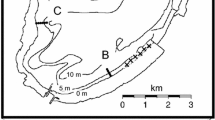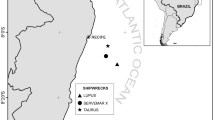Abstract
Sympatric sea urchin species are usually considered to belong to the same grazer guild. Nevertheless, their role in community dynamics may vary due to species-specific morphological traits, feeding preferences and foraging behavior. In the Mediterranean Sea, the two species Paracentrotus lividus and Arbacia lixula co-occur in barren areas. Whereas P. lividus is usually considered responsible for creating a barren ground, the roles of the two sea urchin species in its maintenance are currently unclear. The relative and combined effects of P. lividus and A. lixula on maintaining the benthic community in the barren state were tested experimentally, using orthogonal exclusion of the two species. Results show that exclusion of A. lixula, regardless of the presence of P. lividus, led to a significant decrease in the surface of bare rock and a significant change of the algal assemblages, thus demonstrating the major role of this species in maintaining the barren state.



Similar content being viewed by others
References
Airoldi L (2000) Responses of algae with different life histories to temporal and spatial variability of disturbance in subtidal reefs. Mar Ecol Prog Ser 195:81–92. doi:10.3354/meps195081
Anderson MJ (2001) A new method for non-parametric multivariate analysis of variance. Austral Ecol 26:32–46. doi:10.1111/j.1442-9993.2001.01070.pp.x
Anderson MJ, Robinson J (2003) Generalized discriminant analysis based on distances. Aust NZ J Stat 45:301–318
Andrew NL, Underwood AJ (1993) Density-dependent foraging in the sea urchin Centrostephanus rodgersii on shallow subtidal refs in New South Wales, Australia. Mar Ecol Prog Ser 99:89–98
Benedetti-Cecchi L, Cinelli F (1995) Habitat heterogeneity, sea urchin grazing and the distribution of algae in littoral rock pools on the west coast of Italy (western Mediterranean). Mar Ecol Prog Ser 126:203–212. doi:10.3354/meps126203
Benedetti-Cecchi L, Bulleri F, Cinelli F (1998) Density dependent foraging of sea urchins in shallow subtidal reefs on the west coast of Italy (western Mediterranean). Mar Ecol Prog Ser 163:203–211. doi:10.3354/meps163203
Blackstone NW (1998) Morphological, physiological and metabolic comparisons between runner-like and sheet-like inbred lines of a colonial hydroid. J Exp Biol 201:2821–2831
Bonaviri C, Vega Fernández T, Badalamenti F, Gianguzza P, Di Lorenzo M, Riggio S (2009) Relative role of fish vs. starfish predation in controlling sea urchin populations in Mediterranean rocky shores. Mar Ecol Prog Ser 382:129–138
Breitburg DL (1984) Residual effects of grazing: inhibition of competitor recruitment by encrusting coralline algae. Ecology 65:1136–1143
Breitburg DL (1985) Development of a subtidal epibenthic community: factors affecting species composition and the mechanisms of succession. Oecologia 65:173–184. doi:10.1007/BF00379215
Bulleri F, Benedetti-Cecchi L, Cinelli F (1999) Grazing by the sea urchins Arbacia lixula L. and Paracentrotus lividus Lam. in the Northwest Mediterranean. J Exp Mar Biol Ecol 24:81–95. doi:10.1016/S0022-0981(99)00073-8
Bulleri F, Bertocci I, Micheli F (2002) Interplay of encrusting coralline algae and sea urchins in maintaining alternative habitats. Mar Ecol Prog Ser 243:101–109. doi:10.3354/meps243101
Bulleri F, Tamburello L, Benedetti-Cecchi L (2009) Loss of consumers alters the effects of resident assemblages on the local spread of an introduced macroalga. Oikos 118:269–279. doi:10.1111/j.1600-0706.2008.16955.x
Dethier MN, Graham ES, Cohen S, Tear LM (1993) Visual versus random-point percent cover estimations: “objective” is not always better. Mar Ecol Prog Ser 96:93–100
Dill LM, Heithaus MR, Walters CJ (2003) Behaviorally mediated indirect interactions in marine communities and their conservation implications. Ecology 84:1151–1157. doi:10.1890/0012-9658(2003)084[1151:BMIIIM]2.0.CO;2
Fanelli G, Piraino S, Belmonte G, Geraci S, Boero F (1994) Human predation along the Apulian rocky coast (SE Italy): desertification caused by Lithophaga lithophaga (Mollusca) fisheries. Mar Ecol Prog Ser 110:1–8
Fernández C, Boudouresque CF (1997) Phenotypic plasticity of Paracentrotus lividus (Echinodermata: Echinoidea) in a lagoonal environment. Mar Ecol Prog Ser 152:145–154. doi:10.3354/meps152145
Folke C, Carpenter S, Walker B, Scheffer M, Elmqvist T, Gunderson L, Holling CS (2004) Regime shifts, resilience, and biodiversity in ecosystem management. Annu Rev Ecol Evol Syst 35:557–581. doi:10.1146/annurev.ecolsys.35.021103.105711
Frantzis A, Berthon JF, Maggiore F (1988) Relations trophique entre les oursin Arbacia lixula et Paracentrotus lividus (Echinoidea Regularia) et le phytobenthos infralittoral superficial dans la baie de Port-Cros (Var, rance). Sci Rep Port-Cros Nat Park Fr 14:81–140
Freeman A (2006) Size-dependent trait-mediated indirect interactions among sea urchin herbivores. Behav Ecol 17:182–187. doi:10.1093/beheco/arj014
Gagnon P, Himmelman JH, Johnson LE (2004) Temporal variation in community interfaces: kelp-bed boundary dynamics adjacent to persistent urchin barrens. Mar Biol 144:1191–1203. doi:10.1007/s00227-003-1270-x
Gianguzza P, Chiantore M, Bonaviri C, Cattaneo-Vietti R, Vielmini I, Riggio S (2006) The effects of recreational Paracentrotus lividus fishing on distribution patterns of sea urchins at Ustica Island MPA (Western Mediterranean, Italy). Fish Res 81:37–44. doi:10.1016/j.fishres.2006.06.002
Gianguzza P, Bonaviri C, Milisenda G, Barcellona A, Agnetta D, Vega Fernández T, Badalamenti F (2010) Macroalgal assemblage type affects predation pressure on sea urchins by altering adhesion strength. Mar Environ Res 70:82–86. doi:10.1016/j.marenvres.2010.03.006
Guidetti P (2006) Marine reserves reestablish lost predatory interactions and cause community changes in rocky reefs. Ecol Appl 16:963–976. doi:10.1890/1051-0761(2006)016[0963:MRRLPI]2.0.CO;2
Guidetti P, Dulčić J (2007) Relationship among predatory fish, sea urchins and barrens in Mediterranean rocky reefs across a latitudinal gradient. Mar Environ Res 63:168–184. doi:10.1016/j.marenvres.2006.08.002
Guidetti P, Fraschetti S, Terlizzi A, Boero F (2003) Distribution patterns of sea urchins and barrens in shallow Mediterranean rocky reefs impacted by the illegal fishery of the rock-boring mollusc Lithophaga lithophaga. Mar Biol 143:1135–1142. doi:10.1007/s00227-003-1163-z
Hereu B (2006) Depletion of palatable algae by sea urchins and fishes in a Mediterranean subtidal community. Mar Ecol Prog Ser 313:95–103. doi:10.3354/meps313095
Hereu B, Zabala M, Sala E (2008) Multiple controls of community structure and dynamics in a sublittoral marine environment. Ecology 89:3423–3435. doi:10.1890/07-0613.1
Jackson JBC (1979) Morphological strategies of sessile animals. In: Larwood G, Rosen B (eds) Biology and systematics of colonial animals. Academic Press, London, pp 499–556
Johnson CR, Mann KH (1986) The crustose coralline alga, Phymatolithon Foslie, inhibits the overgrowth of seaweeds without relying on herbivores. J Exp Mar Biol Ecol 96:127–146. doi:10.1016/0022-0981(86)90238-8
Johnson CR, Mann KH (1988) Diversity, patterns of adaptation, and stability of Nova Scotia kelp beds. Ecol Monogr 58:129–154
Kempf M (1962) Recherchs d’ècologie comparée sur Paracentrotus lividus (Lmk.) et Arbacia lixula (L.). Rec Trav Stn Mar Endoume Fac Sci Mars 25:47–116
Knowlton N (2004) Multiple “stable” states and the conservation of marine ecosystems. Progr Oceanogr 60:387–396. doi:10.1016/j.pocean.2004.02.011
Lauzon-Guay J-S, Scheibling RE (2007) Behaviour of sea urchin (Strongylocentrotus droebachiensis) grazing fronts: food-mediated aggregation and density-dependent facilitation. Mar Ecol Prog Ser 329:191–204. doi:10.3354/meps329191
Levitan DR, Sewell MA, Chia FS (1992) How distribution and abundance influence fertilization success in the sea urchin Strongylocentotus franciscanus. Ecology 13:248–254
Ling SD, Johnson CR, Frusher S, Ridgwa K (2009) Overfishing reduces resilience of kelp beds to climate-driven catastrophic phase shift. PNAS 106:22341–22345. www.pnas.org/cgi/doi/10.1073/pnas.0907529106
Ling SD, Ibbott S, Sanderson JC (2010) Recovery of canopy-forming macroalgae following removal of the enigmatic grazing sea urchin Heliocidaris erythrogramma. J Exp Mar Biol Ecol 395:135–146. doi:10.1016/j.jembe.2010.08.027
Micheli F, Benedetti-Cecchi L, Gambaccini S, Bertocci I, Borsini C, Chato Osio G, Romano F (2005) Cascading human impacts, marine protected areas, and the structure of Mediterranean reef assemblages. Ecol Monogr 75:81–102. doi:10.1890/03-4058
Palacín C, Giribet G, Carner S, Dantart L, Turin X (1998) Low density of sea urchins influence the structure of algal assemblages in the western Mediterranean. J Sea Res 39:281–290
Petraitis PS, Dudgeon SR (2004) Detection of alternative stable states in marine communities. J Exp Mar Biol Ecol 300:343–371. doi:10.1016/j.jembe.2003.12.026
Privitera D, Chiantore M, Mangialajo L, Glavic N, Kozul W, Cattaneo-Vietti R (2008) Inter- and intra-specific competition between Paracentrotus lividus and Arbacia lixula in resource-limited barren areas. J Sea Res 60:184–192. doi:10.1016/j.seares.2008.07.001
Régis MB (1979) Particularités microstructurales du squelette de Paracentrotus lividus et Arbacia lixula: rapports avec l’écologie et l’éthologie de ces échinoïdes. Mar Biol 54:373–382
Sala E, Zabala M (1996) Fish predation and the structure of the sea urchin Paracentrotus lividus populations in the NW Mediterranean. Mar Ecol Prog Ser 140:71–81. doi:10.3354/meps140071
Sala E, Boudouresque CF, Harmelin-Vivien M (1998) Fishing, trophic cascades, and the structure of algal assemblages: evaluation of an old but untested paradigm. Oikos 82:425–439
Shears NT, Babcock RC (2002) Marine reserves demonstrate top-down control of community structure on temperate reef. Oecologia 132:131–142. doi:10.1007/s00442-002-0920-x
Shears NT, Babcock RC, Salomon AK (2008) Context-dependent effects of fishing: variation in trophic cascades across environmental gradients. Ecol Appl 18:1860–1873
Steneck RS, Dethier MN (1994) A functional group approach to the structure of algal-dominated communities. Oikos 69:476–498
Steneck RS, Graham MH, Bourque BJ, Corbett D, Erlandson JM, Estes JA, Tegner MJ (2002) Kelp forest ecosystems: biodiversity, stability, resilience and future. Environ Conserv 29:436–459. doi:10.1017/S0376892902000322
Suding KN, Gross KL, Houseman GR (2004) Alternative states and positive feedbacks in restoration ecology. Trends Ecol Evol 19:46–53. doi:10.1016/j.tree.2003.10.005
Verlaque M (1987) Relations entre Paracentrotus lividus (Lamarck) et le phytobenthos de Mediterranee occidentale. In: Boudoresque CF (ed) Colloque International sur Paracentrotus lividus et les oursins comestibles. GIS Posidonie Publication, Marseille, pp 5–36
Verlaque M, Nedelec H (1983) Biologie de Paracentrotus lividus sur substrat rocheux en Corse (Mediterranee, France): alimentation des adultes. Vie Milieu 33:191–201
Wright JT, Dworjanyn SA, Rogers CN, Steinberg PD, Williamson JE, Poore AGB (2005) Density-dependent sea urchin grazing: differential removal of species, changes in community composition and alternative community states. Mar Ecol Prog Ser 298:143–156. doi:10.3354/meps298143
Acknowledgments
This work is dedicated to the late O. Daniela Saracino, whose kind and patient teaching was an essential legacy. The authors wish to thank Davide Agnetta, Andrea Barcellona, Manfredi Di Lorenzo, Francesco Di Trapani, Davide Perricone, Fernando Rubino and Clauda Scianna for their assistance in the field experiments and Giuseppe Portacci for his assistance in image analysis. The authors are indebted to Julie-Anne Buck for revising the English text. Three anonymous reviewers greatly improved the manuscript. This study was funded by the MPA “Isola di Ustica” and the Italian Ministry of the Environment and Protection of the Territory (MATT).
Author information
Authors and Affiliations
Corresponding author
Additional information
Communicated by F. Bulleri.
Rights and permissions
About this article
Cite this article
Bonaviri, C., Vega Fernández, T., Fanelli, G. et al. Leading role of the sea urchin Arbacia lixula in maintaining the barren state in southwestern Mediterranean. Mar Biol 158, 2505–2513 (2011). https://doi.org/10.1007/s00227-011-1751-2
Received:
Accepted:
Published:
Issue Date:
DOI: https://doi.org/10.1007/s00227-011-1751-2




